Back to Journals » Journal of Pain Research » Volume 14
Bibliometric Analysis of Research Trends on Acupuncture for Neck Pain Treatment Over the Past 20 Years
Authors Park J, Kim H, Kim KW, Cho JH, Chung WS, Song MY
Received 28 July 2021
Accepted for publication 30 September 2021
Published 12 October 2021 Volume 2021:14 Pages 3207—3221
DOI https://doi.org/10.2147/JPR.S331514
Checked for plagiarism Yes
Review by Single anonymous peer review
Peer reviewer comments 2
Editor who approved publication: Dr Houman Danesh
Jaehyeon Park, 1,* Hyungsuk Kim, 1, 2,* Koh-Woon Kim, 1 Jae-Heung Cho, 1, 2 Won-Seok Chung, 1, 2 Mi-Yeon Song 1
1Department of Korean Rehabilitation Medicine, College of Korean Medicine, Kyung Hee University, Seoul, Republic of Korea; 2Department of Korean Rehabilitation Medicine, Kyung Hee University Medical Center, Seoul, Republic of Korea
*These authors contributed equally to this work
Correspondence: Mi-Yeon Song
Department of Korean Rehabilitation Medicine, College of Korean Medicine, Kyung Hee University, 23 Kyungheedae-ro, Dongdaemun-gu, Seoul, 02447, Republic of Korea
Tel +82 2-440-7141
Fax +82 2-958-9104
Email [email protected]
Abstract: A bibliometric approach using network analytical methods was applied to explore the research trends on acupuncture for neck pain treatment. Publications related to acupuncture for neck pain treatment from 2000 to 2020 were retrieved from the Web of Science database. The extracted records were analyzed in terms of publication year, research area, journal title, country, organization, authors, and keywords. The research trends on acupuncture for neck pain treatment were visualized using the VOSviewer program. Analyses of 325 articles revealed that the total number of publications has continually increased over the last 20 years. The most represented research area was integrative complementary medicine. The country producing the most articles was the US, followed by China, England, and the Republic of Korea. By assessing the total link strength of organizations and authors, we identified influential organizations and authors who have contributed to research on acupuncture for neck pain treatment. A network analysis based on the cooccurrence of keywords revealed the following two major study designs: clinical study and research methodology. This study examined the research trends on acupuncture for neck pain treatment using bibliometric methods. Our findings provide useful guidelines for researchers in searching for relevant topics.
Keywords: acupuncture, bibliometric analysis, cervical pain, neck pain, network analysis
Two Letters to the Editor have been received and published for this article
A Response to Letter by Dong and Wu has been published for this article.
A Response to Letter by Zhang and Zhang has been published for this article.
Introduction
Neck pain, which is caused by neck damage, stiff neck, or cervical disease, refers to pain and movement disorders in the neck area. It can be induced by trauma, invasion of external pathogens (eg, wind-cold dampness), weakness, or multiple causes. Consequently, neck pain can cause tension, movement disorders, stiffness, radiating pain, and other forms of pain.1 It is a common musculoskeletal disease, and according to the 2017 statistics on the leading cause of global years lived with disability, it ranked 9th in women and 11th in men.2 Almost half of adults experience neck pain at least once in their lifetime,3 and more than 50% of acute neck pain cases last longer than 1 year from onset.4 Although neck pain does not adversely influence an individual’s life itself, it affects the quality of life.5
Conventional treatments, including drugs, injections, and surgeries, are known to reduce neck pain;6,7 however, these interventions can also induce adverse events, such as gastrointestinal, cardiovascular, and renal complications; nerve damage; hemorrhage; and readmission.8–10 Thus, an increasing number of patients seek complementary and alternative medicine (CAM) for effective and safe treatment of neck pain.
Acupuncture therapy, which originated from ancient China,11 is one of the most popular CAM therapies in the world and widely used to effectively manage neck pain.12 Numerous studies have shown the benefits of acupuncture on neck pain, including pain relief,13–17 improved quality of life,18 reduced rate of cervical surgery,19 and cost-effectiveness.20 One of the reasons patients seek acupuncture therapy is because of its safety and effectiveness. However, notwithstanding the popularity in clinics and research areas, no studies have yet analyzed the publication trends on acupuncture for neck pain treatment via visual analyses.
Bibliometric methods are quantitative methods that analyze large volumes of literature in a specific field using mathematical and statistical tools. By measuring the cooccurrence of information—authors, organizations, countries, keywords, and number of citations—in the literature, we can possibly understand various network relationships.21 This analytical method has been applied in many areas with large numbers of studies accumulated, including those on CAM. Jeon et al,22 Park et al,23 Moon et al,24 and Chen et al25 employed a bibliometric method to explore the general prescription of acupuncture, moxibustion, bee venom, and traditional Chinese medicine formula. In addition, Lee et al26 analyzed articles on acupuncture for pain treatment. Liang et al27 also evaluated the research trends on acupuncture for low back pain, while Li et al28 reviewed acupuncture therapy for knee osteoarthritis.
In this study, we aimed to (a) analyze a large number of studies on acupuncture for neck pain treatment from a macroscopic perspective using a bibliometric method, (b) understand the characteristics of network data among the studies, and (c) discuss future research directions and specific tasks that may be undertaken in related research areas.
Materials and Methods
Data Sources, Search Strategies, and Coding
A systematic literature search was conducted using the Web of Science database to identify relevant papers. The following search string was used to generate the initial search results: “(acupuncture OR electroacupuncture) AND (cervical pain OR neck pain).” This yielded 658 papers, which were further analyzed using the following inclusion criteria: (a) published from January 1, 2000 to December 4, 2020, (b) classified as an “article” or “review,” (c) written in English, and (d) had an abstract. The papers were manually selected on the basis of their titles and abstracts. Specifically, studies on acupuncture with needle insertion, ear acupuncture, and electroacupuncture were included, whereas those on pharmacopuncture, injection, acupressure, laser acupuncture, and transcutaneous electrical nerve stimulation were excluded. Using these systematic criteria, we finally included 325 articles. The authors were processed on the basis of their full names.
Data Analysis
The papers were coded in terms of publication year, research area, journal, country, organization, authors, and keywords. The results were analyzed and visualized using VOSviewer (v1.6.15; The Center for Science and Technology Studies, Leiden University, Leiden, The Netherlands), a program that maps bibliometric network data.29
In the visualization using the VOSviewer program, the attraction/repulsion values in the layout items were set differently to yield clear representations of each of the organization, author, and keyword items (organization: attraction, 4/repulsion, −2; author: attraction, 5/repulsion, −4; keywords: attraction, 3/repulsion, −1).
Results
Distribution by Year
The frequency of publication gradually increased from 5 publications in 2000 to 25 in 2018. Throughout the steady increase observed every year, 44 papers were published in 2019, which was the highest recorded number of publications in a year (Figure 1).
 |
Figure 1 Distribution of publications by year. |
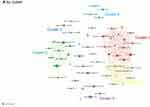 |
Figure 2 Continue. |
 |
Figure 2 Continue. |
Distribution by Research Area
In terms of research area, the area of integrative and complementary medicine (38.2%) yielded the most papers, followed by the areas of neuroscience and neurology (21.2%), general and internal medicine (15.7%), rehabilitation (13.2%), and anesthesiology (10.8%) (Table 1).
 |
Table 1 Distribution of the Publications by Research Area |
Distribution by Journal Title
In terms of journals, Evidence-based Complementary and Alternative Medicine (5.8%) was the most frequently publishing journal, followed by the Journal of Alternative and Complementary Medicine (5.2%), Acupuncture in Medicine (3.7%), Complementary Therapies in Medicine (3.7%), and Pain (3.4%) (Table 2).
 |
Table 2 Distribution of the Publications by Journal Title |
Distribution by Country
In terms of publishing countries, the US (30.5%) had the most publications, followed by China (21.8%), England (12.0%), the Republic of Korea (10.2%), and Germany (7.4%) (Table 3).
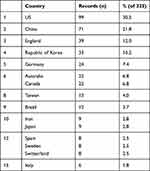 |
Table 3 Distribution of the Publications by Country |
Distribution by Organization
In terms of research organizations, the University of York, UK, (5.5%) and Kyung Hee University (4.3%) published the most papers, followed by Jaseng Hospital of Korean Medicine and Memorial Sloan Kettering Cancer Center, with 11 articles (3.4%) each. The University of Southampton ranked fifth, with 10 papers (3.1%) published (Table 4).
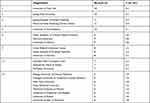 |
Table 4 Distribution of the Publications by Organization |
The organizations were analyzed using VOSviewer. First, the organizations that published more than three papers were identified. Of 73 organizations, 59 were divided into six clusters (Figure 2A). Cluster 1 consisted of 15 organizations, including the University of Alberta, University of Toronto, and Canadian Memorial Chiropractic College. Cluster 2 consisted of 14 organizations, including the University of York, UK, Memorial Sloan Kettering Cancer Center, and the University of Southampton. Cluster 3 consisted of 10 organizations, including the China Academy of Chinese Medical Sciences, Harvard University, and Beijing University of Chinese Medicine. Cluster 4 consisted of nine organizations, including the University of California, Los Angeles; Karolinska Institute; and Stanford University. Cluster 5 consisted of seven organizations, including Kyung Hee University, Jaseng Hospital of Korean Medicine, and the Korea Institute of Oriental Medicine. Cluster 6 consisted of four organizations, including China Medical University Taiwan, China Medical University Hospital, Taiwan City Hospital, and Taipei City Hospital.
Second, the results were classified according to the average publication year by organization (Figure 2B). The yellow color in Figure 2B indicates that the organizations had published papers in recent years, and the blue color indicates otherwise. The University of Munich in Germany had the oldest average publication year (2007.0). The Icahn School of Medicine at Mount Sinai and Oregon Health & Science University in the US had the most recent average publication year (2019.0).
Third, the publications from every organization were classified according to their average number of citations (Figure 2C). The yellow color in Figure 2C indicates more citations, and the blue color indicates otherwise. The network map of the average number of citations revealed that Keele University in England had the highest average number of citations (238.0), while Daejeon University had the lowest average number of citations (1.7).
Distribution by Author
In terms of authors, Hugh MacPherson of the University of York, UK, (5.5%) had published the most papers, followed by Claudia Witt of the University Hospital Zurich (4.0%), In-Hyuk Ha of Jaseng Hospital of Korean Medicine (3.4%), Andrew Vickers of Memorial Sloan Kettering Cancer Center (3.1%), and Pierre Cote of Ontario Tech University (2.8%) (Table 5).
 |
Table 5 Distribution of the Publications by Author |
The authors were analyzed using the VOSviewer program. First, 60 of the 81 authors who had published more than three papers were classified into six clusters (Figure 3A). Cluster 1 consisted of 13 authors, including Kristi Randhawa, Yu Hainan, and Carlo Ammendolia. Cluster 2 consisted of 13 authors, including Hugh MacPherson, Kathleen Ballard, and Julia Woodman. Cluster 3 consisted of 12 authors, including Claudia Witt, Andrew Vickers, and Dominik Irnich. Cluster 4 consisted of 11 authors, including Pierre Cote, Margareta Nordin, and Linda Carroll. Cluster 5 consisted of seven authors, including In-Hyuk Ha, Me-riong Kim, and Yoon Jae Lee. Cluster 6 consisted of four authors, including Cesar Amorim, Daniela Aparecida Biasotto-Gonzalez, and Nivea Cristina De Melo. Figure 3 Continue. Figure 3 Continue.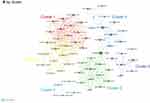

Second, the author results were analyzed according to the average publication year (Figure 3B). The yellow color indicates the authors who had published in recent years, and the blue color indicates otherwise. According to the analysis, Benno Brinkhaus of Germany, Jaime Guzman of the US, Sheilah Hogg-Johnson of Canada, and Lena Holm of Sweden had the oldest average publication year (2008.0), while Yoon Jae Lee had published the most recent papers (2018.5).
Third, the author results were classified according to the average number of citations (Figure 3C). The yellow color indicates more citations, and the blue color indicates otherwise. The analysis showed that Nadine Foster of England had the highest average number of citations (238.0), while In-Hyuk Ha had the lowest average number of citations (3.1).
Analysis of Keywords
The keywords used in the 325 papers were analyzed using VOSviewer. Among the 7483 keywords extracted from the article titles and abstracts, 41 keywords that were mentioned more than 25 times were analyzed; the keywords were classified into three clusters (Figure 4A). The top keywords in Cluster 1 were “group” (149 times), “week” (87 times), “score” (75 times), and “session” (75 times). The top keywords in Cluster 2 were “therapy” (123 times), “evidence” (109 times), “data” (85 times), and “condition” (70 times). The top keyword in Cluster 3 was “case” (37 times). Figure 4 Continue. Figure 4 Continue.

The keyword results were then classified according to the average publication year (Figure 4B). The yellow color indicates the keywords that were used in recent publications, and the blue color indicates otherwise.
Afterward, the keyword results were classified according to the average number of citations of the papers that contained them (Figure 4C). The yellow color indicates more citations, and the blue color indicates otherwise.
The analysis of the average publication year by cluster showed that Cluster 2 (2013.9) published earlier than did Clusters 1 and 3. In addition, the average number of citations in Cluster 2 was 30.8, which was higher than that in Clusters 1 and 3 (Table 6).
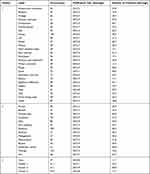 |
Table 6 Clusters of the Keywords by the Average Publication Year and Number of Citations |
Discussion
The main finding of this study with a total of 325 selected papers is that we were able to identify the research trends on acupuncture for neck pain treatment using visual methods, including tables and figures. The number of research studies on this treatment method has gradually increased over the last two decades, indicating that acupuncture is becoming more popular among researchers, clinicians, and patients.
The area of the top publishing journal was integrated and complementary medicine. This indicates that papers on acupuncture for neck pain treatment are more favored in CAM journals that are focused on the intervention of traditional Chinese medicine than in other department-specific medical journals. Researchers need to broaden their choice of journal to journals of other areas to better disseminate information on the excellence of acupuncture among medical professionals who only have a keen interest in Western medicine.
In terms of publishing countries, the US, China, England, the Republic of Korea, and Germany were the top five countries researching on this topic. If the database was not limited to the English-based Web of Science database, Asian countries would have more published records because acupuncture is widely accepted in East Asian countries.
In terms of authors, Hugh MacPherson, Claudia Witt, and In-Hyuk Ha were the top three authors with the highest number of published papers. Cluster 1 mainly included Canadian authors from Ontario Tech University, while Cluster 2 had the most English authors from the University of York, UK. European authors were primarily included in Cluster 3, with authors from Charite Medical University of Berlin forming the largest group of researchers. The highest average number of citations in Cluster 3 was 113.2. Nadine Foster of England, who had the highest average number of citations, was also included in Cluster 3. The average publication year was 2011.4, which was the second oldest. The authors in Cluster 4 were from different organizations, but with most of them hailing from the US and Canada. The average publication year was 2010.6, which was the oldest. Cluster 5 included researchers from the Republic of Korea, specifically Jaseng Hospital of Korean Medicine, Kyung Hee University, and Pusan National University. The average publication year was 2017.7, which was the most recent among the clusters. Among the authors in Cluster 5, Yoon Jae Lee had an average publication year of 2018.5, which indicates that he had published several articles in recent years. In Cluster 6, there were numerous authors from Universidade Nove de Julho, all of whom were from Brazil. Our analysis revealed that the average number of citations of the papers published by European authors was generally high.
Organizations in the Republic of Korea had recently published a large number of research studies on acupuncture, ranking fourth in terms of the number of publications by country. It appears that organizations the Republic of Korea have made significant progress in a short period compared to older and more established organizations in Europe. However, the average number of citations of the publishing authors in the Republic of Korea (6.0) was the second lowest. The gap between the two types of ranking lists indicates that many studies are published but less cited in other studies; this finding needs to be pointed out to the researchers in the country.
The top ranking authors were also analyzed according to the contents of the studies. First, we determined that some authors, including Hugh MacPherson of Cluster 2 and Claudia Witt, Andrew Vickers, Dominik Irnich, George Lewith, Karen Sherman, Stefan Willich, and Nadine Foster of Cluster 3, were members of Acupuncture Trialists. They studied chronic pain treated with acupuncture.30,31 This group disclosed that among several patient characteristics, the pain severity at baseline was related to the effect of acupuncture on chronic pain.32 However, the application of this criterion in clinical situations is limited because of lack of clinical applicability. Second, Pierre Cote, Margareta Nordin, Linda Carroll, and Gabrielle van der Velde of Cluster 4 are often involved in the same studies. They were included in the task force on neck pain and usually conducted studies according to clinical practice guidelines.33 Among the authors from the Republic of Korea in Cluster 5, In-Hyuk Ha, Me-riong Kim, Yoon Jae Lee, and Jinho Lee from Jaseng Hospital of Korean Medicine co-authored several articles. This group usually conducted studies on the effect of acupuncture and electroacupuncture on neck pain.19,34
In terms of keywords, those in Cluster 1 were commonly used terms in clinical trials, including “group,” “week,” “score,” “session,” and “acupuncture treatment.” The keywords in Cluster 2 were terms related to research methodology, including “therapy,” “evidence,” “data,” “condition,” “systematic review,” and “meta-analysis”. The keywords in Cluster 3 were insufficient for analysis, as only one keyword (“case”) was retrieved. Cluster 2 had an earlier average publication year and a higher average number of citations than the other clusters. There appeared to be diverse opportunities for these papers to be cited, as they had the earliest average publication year.
This study has some limitations. Only papers written in English in the Web of Science database were retrieved in this study. Limiting the database to only one source can yield lopsided results but also has an advantage of providing information on clear and lucid research trends in a highly trusted database. Second, this study included various studies of different quality with the same emphasis on each article. Without relation to the type and the quality of studies, bibliometric analysis only explores on the distribution and the number of conducted studies. However, this is a characteristic of the analysis and it targets the quantitative research trend.
Our results suggest several important directions for further research on acupuncture for neck pain treatment. First, we suggest the construction of a more detailed and precise search string that includes relevant keywords not only on neck pain but also on other diseases. The keywords used in this research were “acupuncture” and “neck pain” but these might not be enough to encompass all the diseases that can cause neck pain. Second, considering that this research was conducted on the basis of papers written only in English, further analyses of papers written in other languages would illustrate more accurate research trends on acupuncture for neck pain treatment. Third, as this study broadly reviewed different types of papers, focusing on clinical trials would better capture clinical research trends. Finally, the results of this study could contribute to future research on thoracic spine, pelvic girdle, and joint diseases.
Conclusion
This study analyzed 325 papers on acupuncture for neck pain treatment to analyze research trends over the last two decades using a bibliometric approach. First, our analysis showed that the number of publications increased from 2000 to 2020. Specifically, the number of studies had steadily increased since 2015, demonstrating that research had been actively conducted. Second, in terms of research area and journals, a number of papers had been published in the fields of CAM and pain. Third, in terms of countries, the largest number of papers had been published in the US and in Northeast Asian countries, such as China, Republic of Korea, Taiwan, and Japan. Fourth, in terms of organizations, the University of York, UK, had published the most papers, followed by Kyung Hee University and Jaseng Hospital of Korean Medicine. Fifth, in terms of authors, the publishing authors from Europe had the highest average number of citations, while more authors from the Republic of Korea had recently published more studies. In addition, the top three groups that published co-authored papers were also identified. Sixth, our analysis revealed two major topics: (a) topics used in clinical trials on acupuncture and (b) topics related to research methodology.
Data Sharing Statement
Data may be provided through the corresponding author’s email.
Ethics Approval and Informed Consent
This study did not include any patient information. Thus, the requirement for ethics approval was waived.
Acknowledgments
This research was supported by the Basic Science Research Program through the National Research Foundation of Korea (NRF-2017R1A2B4011707).
Author Contributions
All authors made a significant contribution to the work reported, whether that is in the conception, study design, execution, acquisition of data, analysis and interpretation, or in all these areas; took part in drafting, revising or critically reviewing the article; gave final approval of the version to be published; have agreed on the journal to which the article has been submitted; and agree to be accountable for all aspects of the work.
Funding
This research was supported by the Basic Science Research Program through the National Research Foundation of Korea (NRF-2017R1A2B4011707).
Disclosure
JP and HK are the co-first authors. The authors report no conflicts of interest related to this work.
References
1. Ha JY. Pathology and clinical matters of oriental medicine about neck pain. J Physiol & Pathol Korean Med. 1996;10:6–10.
2. GBD 2017 Disease and Injury Incidence and PrEvalence Collaborators. Global, regional, and national incidence, prevalence, and years lived with disability for 354 diseases and injuries for 195 countries and territories, 1990–2017: a systematic analysis for the Global Burden of Disease Study 2017. Lancet. 2018;392:1789–1858.
3. Fejer R, Kyvik KO, Hartvigsen J. The prevalence of neck pain in the world population: a systematic critical review of the literature. Eur Spine J. 2006;15:834–848. doi:10.1007/s00586-004-0864-4
4. Vasseljen O, Woodhouse A, Bjorngaard JH, Leivseth L. Natural course of acute neck and low back pain in the general population: the HUNT study. Pain. 2013;154:1237–1244. doi:10.1016/j.pain.2013.03.032
5. Vos CJ, Verhagen AP, Passchier J, Koes BW. Clinical course and prognostic factors in acute neck pain: an inception cohort study in general practice. Pain Med. 2008;9:572–580. doi:10.1111/j.1526-4637.2008.00456.x
6. Cohen SP, Hooten WM. Advances in the diagnosis and management of neck pain. BMJ. 2017;358:3221. doi:10.1136/bmj.j3221
7. Mesregah MK, Feng W, Huang WH, et al. Clinical effectiveness of interlaminar epidural injections of local anesthetic with or without steroids for managing chronic neck pain: a systematic review and meta-analysis. Pain Physician. 2020;23:335–348.
8. Fine M. Quantifying the impact of NSAID-associated adverse events. Am J Manag Care. 2013;19:S267–S272.
9. Dagenais S, Ogunseitan A, Haldeman S, Wooley JR, Newcomb RL. Side effects and adverse events related to intraligamentous injection of sclerosing solutions (prolotherapy) for back and neck pain: a survey of practitioners. Arch Phys Med Rehabil. 2006;87:909–913. doi:10.1016/j.apmr.2006.03.017
10. Zakaria HM, Bazydlo M, Schultz L, et al. Adverse events and their risk factors 90 days after cervical spine surgery: analysis from the Michigan spine surgery improvement collaborative. J Neurosurg. 2019;30:602–614.
11. Wu JN. A short history of acupuncture. J Altern Complement Med. 1996;2:19–21. doi:10.1089/acm.1996.2.19
12. Fu LM, Li JT, Wu WS. Randomized controlled trials of acupuncture for neck pain: systematic review and meta-analysis. J Altern Complement Med. 2009;15:133–145. doi:10.1089/acm.2008.0135
13. Farag AM, Malacarne A, Pagni SE, Maloney GE. The effectiveness of acupuncture in the management of persistent regional myofascial head and neck pain: a systematic review and meta-analysis. Complement Ther Med. 2020;49:102297. doi:10.1016/j.ctim.2019.102297
14. Seo SY, Lee KB, Shin JS, et al. Effectiveness of acupuncture and electroacupuncture for chronic neck pain: a systematic review and meta-analysis. Am J Chin Med. 2017;45:1573–1595. doi:10.1142/S0192415X17500859
15. Eslamian F, Jahanjoo F, Dolatkhah N, Pishgahi A, Pirani A. Relative effectiveness of electroacupuncture and biofeedback in the treatment of neck and upper back myofascial pain: a randomized clinical trial. Arch Phys Med Rehabil. 2020;101:770–780. doi:10.1016/j.apmr.2019.12.009
16. Calamita SAP, Biasotto-Gonzalez DA, De Melo NC, et al. Immediate effect of acupuncture on electromyographic activity of the upper trapezius muscle and pain in patients with nonspecific neck pain: a randomized, single-blinded, sham-controlled, Crossover Study. J Manipulative Physiol Ther. 2018;41:208–217. doi:10.1016/j.jmpt.2017.09.006
17. Ho LF, Lin ZX, Leung AWN, et al. Efficacy of abdominal acupuncture for neck pain: a randomized controlled trial. PLoS One. 2017;12:e0181360. doi:10.1371/journal.pone.0181360
18. Onat SS, Polat CS, Bicer S, Sahin Z, Tasoglu O. Effect of dry needling injection and kinesiotaping on pain and quality of life in patients with mechanical neck pain. Pain Physician. 2019;22:583–589.
19. Han DG, Koh W, Shin JS, et al. Cervical surgery rate in neck pain patients with and without acupuncture treatment: a retrospective cohort study. Acupunct Med. 2019;37:268–276. doi:10.1136/acupmed-2018-011724
20. Essex H, Parrott S, Atkin K, et al. An economic evaluation of Alexander technique lessons or acupuncture sessions for patients with chronic neck pain: a randomized trial (ATLAS). PLoS One. 2017;12:e0178918. doi:10.1371/journal.pone.0178918
21. De Bellis N. Bibliometrics and Citation Analysis: From the Science Citation Index to Cybermetrics. Lanham MD: Scarecrow Press; 2009.
22. Jeon SH, Lee IS, Lee H, Chae Y. A bibliometric analysis of acupuncture research trends in clinical trials. Korean J Acupunct. 2019;36:281–291. doi:10.14406/acu.2019.030
23. Park H, Lee IS, Lee H, Chae Y. Bibliometric analysis of moxibustion research trends over the past 20 years. J Clin Med. 2020;9:1254. doi:10.3390/jcm9051254
24. Moon H, Lee IS, Lee H, Chae Y. A bibliometric analysis of bee venom research over the past 20 years. Korean J Acupunct. 2020;37:76–87. doi:10.14406/acu.2020.012
25. Chen YB, Tong XF, Ren JG, Yu CQ, Cui YL. Current research trends in traditional Chinese medicine formula: a bibliometric review from 2000 to 2016. Evid Based Complement Alternat Med. 2019;2019:1–13.
26. Lee IS, Lee H, Chen YH, Chae Y. Bibliometric analysis of research assessing the use of acupuncture for pain treatment over the past 20 years. J Pain Res. 2020;13:367–376. doi:10.2147/JPR.S235047
27. Liang YD, Li Y, Zhao J, Wang XY, Zhu HZ, Chen XH. Study of acupuncture for low back pain in recent 20 years: a bibliometric analysis via CiteSpace. J Pain Res. 2017;10:951–964. doi:10.2147/JPR.S132808
28. Li RR, Sun J, Hu HT, et al. Research trends of acupuncture therapy on knee osteoarthritis from 2010 to 2019: a bibliometric analysis. J Pain Res. 2020;13:1901–1913. doi:10.2147/JPR.S258739
29. Danitta W. VOSviewer. Tech Serv Q. 2018;35:219–220. doi:10.1080/07317131.2018.1425352
30. Vickers AJ, Vertosick EA, Lewith G, et al. Acupuncture for chronic pain: update of an individual patient data meta-analysis. J Pain. 2018;19:455–474. doi:10.1016/j.jpain.2017.11.005
31. MacPherson H, Vertosick EA, Foster NE, et al. The persistence of the effects of acupuncture after a course of treatment: a meta-analysis of patients with chronic pain. Pain. 2017;158:784–793. doi:10.1097/j.pain.0000000000000747
32. Witt CM, Vertosick EA, Foster NE, et al. The effect of patient characteristics on acupuncture treatment outcomes an individual patient data meta-analysis of 20,827 chronic pain patients in randomized controlled trials. Clin J Pain. 2019;35:428–434. doi:10.1097/AJP.0000000000000691
33. Cote P, Wong JJ, Sutton D, et al. Management of neck pain and associated disorders: a clinical practice guideline from the Ontario Protocol for Traffic Injury Management (OPTIMa) collaboration. Eur Spine J. 2016;25:2000–2022. doi:10.1007/s00586-016-4467-7
34. Kim N, Shin BC, Shin JS, et al. Characteristics and status of Korean medicine use in whiplash-associated disorder patients. BMC Complement Altern Med. 2018;18:124. doi:10.1186/s12906-018-2188-7
 © 2021 The Author(s). This work is published and licensed by Dove Medical Press Limited. The
full terms of this license are available at https://www.dovepress.com/terms.php
and incorporate the Creative Commons Attribution
- Non Commercial (unported, v3.0) License.
By accessing the work you hereby accept the Terms. Non-commercial uses of the work are permitted
without any further permission from Dove Medical Press Limited, provided the work is properly
attributed. For permission for commercial use of this work, please see paragraphs 4.2 and 5 of our Terms.
© 2021 The Author(s). This work is published and licensed by Dove Medical Press Limited. The
full terms of this license are available at https://www.dovepress.com/terms.php
and incorporate the Creative Commons Attribution
- Non Commercial (unported, v3.0) License.
By accessing the work you hereby accept the Terms. Non-commercial uses of the work are permitted
without any further permission from Dove Medical Press Limited, provided the work is properly
attributed. For permission for commercial use of this work, please see paragraphs 4.2 and 5 of our Terms.



